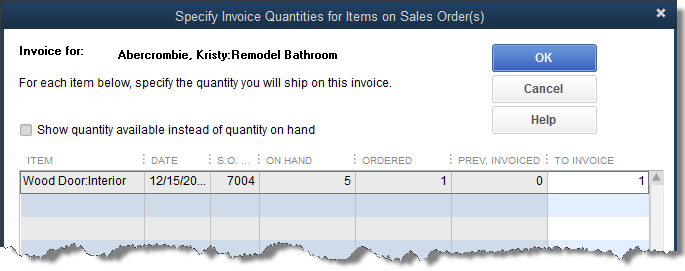Blog 
Click here to go back
Customer Orders

Sales Orders is a feature found in the Premier and Enterprise levels of QuickBooks only.
The sales order creates a non-posting transaction. Like an estimate or purchase order, you can create as many sales orders as you like. You may delete and edit them regardless of date.
Since they don’t affect any of your accounting numbers, these kinds of changes cannot do any harm.
A sales order will keep a record of an order placed by a customer that is not yet ready to invoice. In common, everyday use, they track backorders and special orders.
The first step to using sales orders is to be sure the preference is selected. This allows the feature to be turned on.

A sales order form appears much like an invoice. The popup message in QuickBooks that warns of insufficient quantities works on sales orders just as it does invoices.

The above screenshot shows the perfect scenario for using a sales order. The customer is ordering a door that is not in stock.
Selling into negative inventory, that is, selling inventory not actually on-hand, can have very adverse affects on QuickBooks.
Negative inventory causes issues with the computation of the costs of inventory items sold. It is difficult to compute an average cost when the number on hand is less than zero.
To maintain accurate accounting numbers, negative inventory should always be avoided.
But since a sales order is a non-posting document, we can sell as much non-existing inventory as we want. It’s not really a sale, it’s an order. It will be turned into a sale later when we have sufficient stock to fulfill the order.
The sales order shown in the screenshot can be completed with the quantities the customer wants to purchase. The company will ship when quantities are available.

The Inventory Stock Status report takes into account the amounts on order when computing the Available number. In this instance, the Interior Wood Door has an available quantity of negative 1.
Looking at the screenshot, you can see that QuickBooks shows the on hand quantity as zero. Are there any on sales orders?
Yes, there is one and that is subtracted. Amounts saved for builds of assembly type items are also subtracted to arrive at the available quantity. Any amounts on purchase orders are shown for informational purposes.
Reports also exist in QuickBooks to track outstanding orders, either by customer or by item.
Once Rock Castle Construction has received a shipment of the interior wood doors, we can fulfill our customer’s order.
Normally, we would view one of the sales order reports and double click on the Kristy Abercrombie order to bring up the sales order.
![]()
In the above screenshot, the sales order created earlier is shown. Highlighted on the ribbon is the icon that will allow us to create the invoice. It will be created from this document with little manual entry.
In some cases, a sales order may have multiple lines with different products on order. In such a case, it’s possible to create the invoice for only some of the products.
QuickBooks will keep track of what items have been invoiced and which have not. Multiple invoices can be created from one sales order.

This screenshot is the message QuickBooks will display. It allows the user to select only some of the products, or less than the full quantity of a single product to invoice.
The sales order will remain open and available to be filled until all the items are invoiced.











